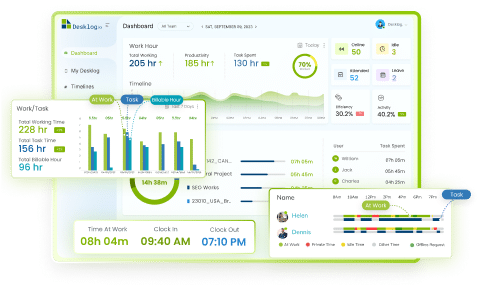A blog on – How Many Working Days Are in a Month? Seems funny right?
But do you know the legal count of working days in a month? You might have not even thought about this amidst the hustle and bustle of daily life. Yet, understanding this seemingly holds far more significance than meets the eye.
Because for organizations, knowing & calculating working days are crucial for effective planning and scheduling, financial management, and moreover for maintaining a work-life balance.
So, Join us as we explore the implications, and the essential insights behind the question: How many working days are in a month?
What is a Working Day?
A working day is the specific duration within a normal day that an individual does their job, adhering to an agreed number of hours. During this time, work is performed in exchange for a salary or wage.
Actually, the term ‘working day’ is a term we often throw around without much thought, assuming everyone understands its meaning. But upon closer inspection, defining a working day reveals layers of complexity and nuance.
While there are 365 days in a year, there are only 260 working days in a year due to weekends, holidays, and a variety of other factors. This can range from the traditional 9-to-5 schedule to more flexible arrangements like remote work or shift-based rotations. However, the specifics can vary widely depending on factors such as industry norms, company policies, and legal regulations.
How Many Work Hours in a Day?
In a day, employees work between 8 to 10 hours, with a maximum of 48 hours per week. However, the weekly limit can be extended to 50 to 60 hours, including overtime. There must be a break of at least 30 minutes after working continuously for more than 5 hours.
In many countries, the standard workday consists of eight hours, with additional breaks for meals and rest periods. However, some professions or industries may have different norms, such as longer shifts for healthcare workers or shorter hours for part-time employees.
Difference Between Working Days and Non-Working Days
A working day simply refers to a day in which an employee is actively engaged in work or is designated to work as per their schedule.
A non-working day is any day when an employee is unavailable to the employer during their usual work hours.
A crucial distinction exists between working days and non-working days, commonly referred to as weekends or holidays. While working days are reserved for professional obligations and productivity, non-working days provide an opportunity for rest, relaxation, and personal pursuits.
Read more: Automated time tracking to track employees’ work hours in a day.How to Calculate Working Days?
Typically, workdays span approximately eight hours. There’s no one-size-fits-all answer because the number of work hours depends on several factors like industries, company policies, location, and individual contract. It may vary as follows:

Standard full-time: In many countries, a standard full-time workweek is around 40 hours, often spread over five 8-hour days.

Part-time: Part-time work can involve anything from a few hours a week to several, depending on the specific agreement.

Shift work: Certain professions, like healthcare or manufacturing, might involve rotating shifts outside of standard working hours.

Flex work: With growing awareness of work-life balance, many companies offer flexible work arrangements allowing employees to adjust their schedules within certain parameters.

The “Nine to Five” Workday: With growing awareness of work-life balance, many companies offer flexible work arrangements allowing employees to adjust their schedules within certain parameters.

A Full 24-Hour Period: Companies offering flexible work hours may consider the entire 24-hour cycle as part of the workday. For instance, in departments like customer support with rotating shifts, the workday extends to midnight of the following date, allowing seamless handover of ongoing tasks.
What is a Working Week?
Working week is the period when most people work throughout the week, normally from Monday to Friday. However, certain occupations may necessitate weekend work.
Working weeks are relatively straightforward compared to the intricacies of working days. In the United States, a standard working week consists of 40 hours. Any hours worked beyond this time period will be counted as overtime.
Given that weekends end the week with a day off, teams operating exclusively on weekdays find it easier to outline their work week without concern for when it starts or ends. This simplicity contrasts sharply with the complexities of coordinating work across potentially 24 different time zones.
Working Week Vs. Calendar Week

Calendar Week
This is the standard seven-day period, starting from Sunday and ending on Saturday. Calendar weeks don’t change – they remain constant throughout the year.

Working Week
This refers to the specific seven days you work in a row. Unlike the calendar week, it’s not fixed and can vary depending on your job or industry. The most common working week is Monday through Friday, but some businesses operate on different schedules.
Understanding the difference between a working week and a calendar week is relatively simple. While most commonly, the working week extends from Monday to Friday , a calendar week encompasses the full seven-day period from Sunday to Saturday.
What is a Working Month
A working month refers to the days in which individuals engage in work-related activities over the course of a calendar month. Typically, a working month spans from the first to the last day of the month, with weekdays – Monday to Friday. However, certain professions or industries may require weekend work or irregular schedules.
In many countries, a standard working month consists of around 20 to 22 business days, excluding weekends and public holidays. Nevertheless, variations may exist depending on local regulations, cultural practices, and industry norms.
In some regions, monthly working hours may be further regulated by labor laws or collective bargaining agreements, ensuring fair compensation for overtime work and adequate rest periods.
Comparison: Working Month vs. Calendar Month
While we often use “month” in everyday conversation, there’s a crucial distinction between a working month and a calendar month, especially in the professional realm. Here’s a breakdown of each:

Calendar Month
This is the standard month as defined by the calendar, lasting 28 to 31 days, depending on the month. It includes all days, including weekdays, weekends, & public holidays. It’s used for various purposes, including scheduling appointments, and tracking date-related events.

Working Month
Working Month refers to a month where an employee is scheduled to work, regardless of the number of days it contains. A working month might specifically exclude non-working days such as Saturdays, Sundays, and public holidays. This can be relevant for calculating hourly pay or other metrics based on actual work hours.
A calendar month spans from the first to the last day of the month. The length of calendar months consists of either 30 or 31 days, except for February.
Let’s illustrate this with an example: December 2024. This month boasts 31 days, with nine weekend days and 1 public holiday:

December 25: Christmas (Wednesday)
To determine the total number of working days in December 2024, subtract the weekends and public holiday from the calendar month:
31 days – 9 weekend days – 1 public holidays = 21 working days
Hence, the working month of December 2024 comprises 21 days dedicated to work responsibilities.
Average Working Days in a Month
A month has between 20 to 22 working days, equivalent to roughly four work weeks. This assumes a full-time employee working eight hours per day, amounting to approximately 160 to 176 hours of work monthly.
The average number of working days can fluctuate. For instance, in a leap year like 2024, February boasts 29 days instead of the usual 28. In February 2020, with nine weekend days and a federal holiday (Washington’s Birthday), there were 19 working days. Conversely, February 2023, despite being a day shorter, had 20 working days due to its placement of the 19th on a Sunday.
Read more: What is 2 2 3 work schedule?Average Working Days in a Year
On average, a year comprises approximately 250 working days. This calculation involves tallying the number of weekdays throughout the year and subtracting the count of holidays.
For instance, in 2023, there were 260 weekdays and 11 holidays, resulting in 249 work days.
However, it’s essential to recognize that this calculation doesn’t encompass other variables such as:
- Paid time off
- State- or country-specific holidays (relevant for international teams)
- Unforeseen emergencies
Automated Software for Scheduling Work Hours
Many organizations use tools and software to automate the scheduling of work hours. One such software is Desklog time tracking software. Desklog allows managers or admins to set specific work hours for tracking, significantly streamlining the process of managing work schedules.
Desklog’s time tracking capabilities are particularly beneficial in planning and setting work hours. By offering real-time tracking, it provides a clear and accurate picture of how time is spent during the workday. Another advantage of Desklog is its flexibility in accommodating various working schedules. Whether an organization follows a traditional nine-to-five routine, shifts work, or has remote or flexible working arrangements, Desklog can be customized to suit these diverse needs.
In Summary
Understanding the number of working days in a month is crucial for planning, budgeting, and managing one’s professional life.
The key takeaway is the importance of customizing your approach to calculating working days based on your specific work situation. This not only ensures accuracy in planning and time management but also helps in aligning with financial and personal goals.
Keep this variability in mind when considering the number of working days in a month for your specific circumstance. Remember, it’s not just the quantity of these days, but the quality of work within them that truly counts.
FAQ
1How many work weeks in a month?
Most months have around four weeks, but sometimes there might be five weeks.
2How many business days in a week?
A typical business week, from Monday to Friday, consists of five days, even though there are seven days in a week.
3How many business days in a month?
Usually a month has 20-22 business days, excluding the weekends and other public holidays. However, it can vary by countries and holidays.
4How many business days in a year?
How many average working days are in a year? On average, there are 250 working days in a year. The formula is simple: count the number of weekdays in the year and then subtract the number of holidays. For example, 2023 had 260 weekdays and 11 holidays, resulting in 249 work days.
5How many hours in a year?
There are 8760 hours in a calendar year. Of course, that definitely shouldn’t be the number of hours you work in a year.
6How many working days in a 12 month period?
In a year, the number of working days can range from 260 to 262, resulting in a total of up to 2,096 working hours. For example, in 2023, there were 260 working days, totaling 2,080 working hours.
7How long is 12 working weeks?
For an employee working half-time, 12 workweeks can mean 30 eight-hour days, 60 four-hour days or 12 workweeks of whatever is the employee’s normal half-time work schedule.
8How many weeks is a work period?
There are 52 working weeks yearly because most businesses are open yearly. However, employees often receive 3-4 weeks off each year, depending on their company. This means the total working weeks in a year will be 48 or 49; this number can vary depending on each person.















